Given: PQ is a perpendicular bisector of side AB of the triangle ABC.
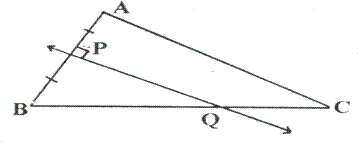
Prove: Q is equidistant from A and B.
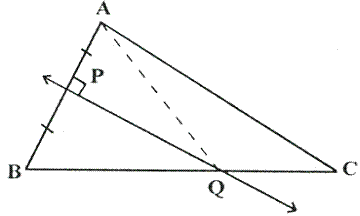
Construction: Join AQ
Proof: In ![]() and
and ![]() ,
,
AP = BP (given)
![]() (Each = 90
(Each = 90![]() )
)
PQ = PQ (Common)

Hence Q is equidistant from A and B.
Given: CP is the bisector of angle C of ![]()

Prove: P is equidistant from AC and BC.
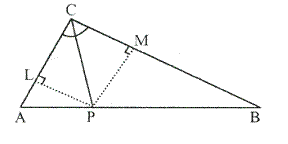
Construction: From P, draw ![]() and
and ![]()
Proof: In ![]() and
and ![]() ,
,

Hence, P is equidistant from AC and AB
Given: AX bisects angle BAC and PQ is perpendicular bisector of AC which meets AX at point Y.
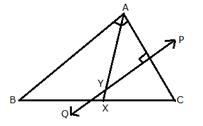
Prove:
i) X is equidistant from AB and AC.
ii) Y is equidistant from A and C
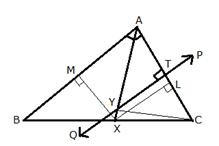
Construction: From X, draw ![]() and
and ![]() . Also join YC.
. Also join YC.
Proof:
i) In ![]() and
and ![]() ,
,

Hence, X is equidistant from AB and AC.
ii) In ![]() and
and ![]() ,
,

Hence, Y is equidistant from A and C.
Construct a triangle ABC, in which AB = 4.2 cm, BC = 6.3 cm and AC = 5 cm. Draw perpendicular bisector of BC which meets AC at point D. Prove that D is equidistant from B and C.
Given: In triangle ABC, AB = 4.2 cm, BC = 6.3 cm and AC = 5 cm
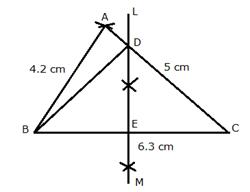
Steps of Construction:
i) Draw a line segment BC = 6.3 cm
ii) With centre B and radius 4.2 cm, draw an arc.
iii) With centre C and radius 5 cm, draw another arc which intersects the first arc at A.
iv) Join AB and AC.
![]() is the required triangle.
is the required triangle.
v) Again with centre B and C and radius greater than ![]() , draw arcs which intersects each other at L and M.
, draw arcs which intersects each other at L and M.
vi) Join LM intersecting AC at D and BC at E.
vii) Join DB.
Proof: In ![]() and
and ![]()

Hence, D is equidistant from B and C.
In each of the given figures: PA = PB and QA = QB
i)

ii)

Prove in each case, that PQ (produced, if required) is perpendicular bisector of AB.
Hence, state the locus of the points equidistant from two given fixed points.
Construction: Join PQ which meets AB in D.
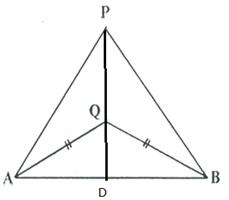

Proof: P is equidistant from A and B.
![]() P lies on the perpendicular bisector of AB.
P lies on the perpendicular bisector of AB.
Similarly, Q is equidistant from A and B.
![]() Q lies on perpendicular bisector of AB.
Q lies on perpendicular bisector of AB.
![]() P and Q both lie on the perpendicular bisector of AB.
P and Q both lie on the perpendicular bisector of AB.
![]() PQ is perpendicular bisector of AB.
PQ is perpendicular bisector of AB.
Hence, locus of the points which are equidistant from two fixed points, is a perpendicular bisector of the line joining the fixed points.
Construct a right angled triangle PQR, in which ![]() , hypotenuse PR = 8 cm and QR = 4.5 cm. Draw bisector of angle PQR and let it meet PR at point T. Prove that T is equidistant from PQ and QR.
, hypotenuse PR = 8 cm and QR = 4.5 cm. Draw bisector of angle PQR and let it meet PR at point T. Prove that T is equidistant from PQ and QR.

Steps of Construction:
i) Draw a line segment QR = 4.5 cm
ii) At Q, draw a ray QX making an angle of ![]()
iii) With centre R and radius 8 cm, draw an arc which intersects QX at P.
iv) Join RP.
![]() is the required triangle.
is the required triangle.
v) Draw the bisector of ![]() which meets PR in T.
which meets PR in T.
vi) From T, draw perpendicular PL and PM respectively on PQ and QR.
Proof: In ![]() and
and ![]()

Hence, T is equidistant from PQ and QR.
Construct a triangle ABC in which angle ![]() , AB = 5cm and BC = 6.4 cm. Draw perpendicular bisector of side BC and also the bisector of angle ACB. If these bisectors intersect each other at point P; prove that P is equidistant from B and C; and also from AC and BC.
, AB = 5cm and BC = 6.4 cm. Draw perpendicular bisector of side BC and also the bisector of angle ACB. If these bisectors intersect each other at point P; prove that P is equidistant from B and C; and also from AC and BC.
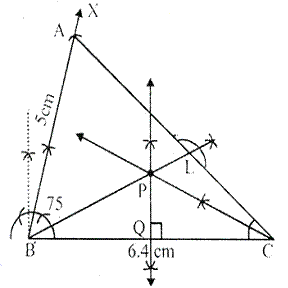
Steps of Construction:
i) Draw a line segment BC = 6.4 cm
ii) At B, draw a ray BX making an angle of ![]() with BC and cut off BA = 5 cm.
with BC and cut off BA = 5 cm.
iii) Join AC.
![]() is the required triangle.
is the required triangle.
iv) Draw the perpendicular bisector of BC.
v) Draw the angle bisector of angle ACB which intersects the perpendicular bisector of BC at P.
vi) Join PB and draw ![]() .
.
Proof: In ![]() and
and ![]()

Hence, P is equidistant from B and C.
Again in ![]() and
and ![]()

Hence, P is equidistant from AC and BC.
In parallelogram ABCD, side AB is greater than side BC and P is a point in AC such that PB bisects angle B. Prove that P is equidistant from AB and BC.
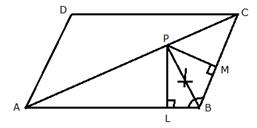
Construction: From P, draw ![]() and
and ![]()
Proof: In ![]() and
and ![]()

Hence, P is equidistant from AB and BC.
In triangle LMN, bisectors of interior angles at L and N intersect each other at point A.
Prove that -
i) point A is equidistant from all the three sides of the triangle.
ii) AM bisects angle LMN.
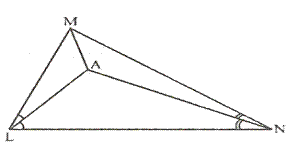
Construction: Join AM
Proof:
![]() A lies on bisector of
A lies on bisector of ![]()
![]() A is equidistant from MN and LN.
A is equidistant from MN and LN.
Again, A lies on bisector of ![]()
![]() A is equidistant from LN and LM.
A is equidistant from LN and LM.
Hence, A is equidistant from all sides of the triangle LMN.
![]() A lies on the bisector of
A lies on the bisector of ![]()
Use ruler and compasses only for this question.
(i)Construct ![]() , where AB = 3.5 cm, BC = 6 cm and
, where AB = 3.5 cm, BC = 6 cm and ![]()
(ii)Construct the locus of points inside the triangle which are equidistant from BA and BC.
(iii)Construct the locus of points inside the triangle which are equidistant from B and C.
(iv)Mark the point P which is equidistant from AB, BC and also equidistant from B and C. Measure and record the length of PB.
Steps of construction:
(i)Draw line BC = 6 cm and an angle CBX = 60o. Cut off AB = 3.5. Join AC, triangle ABC is the required triangle.
(ii)Draw perpendicular bisector of BC and bisector of angle B
(iii)Bisector of angle B meets bisector of BC at P.
![]() BP is the required length, where, PB = 3.5 cm
BP is the required length, where, PB = 3.5 cm
(iv)P is the point which is equidistant from BA and BC, also equidistant from B and C.
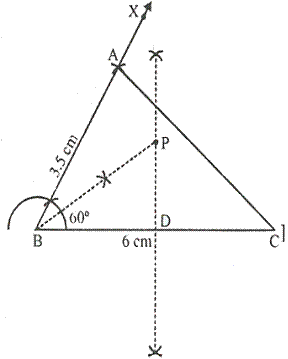
PB=3.6 cm
The given figure shows a triangle ABC in which AD bisects angle BAC. EG is perpendicular bisector of side AB which intersects AD at point F.
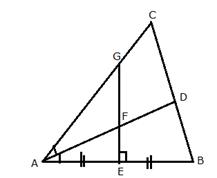
Prove that:
i) F is equidistant from A and B.
ii) F is equidistant from AB and AC.
i)

Construction: Join FB and FC
Proof: In ![]() and
and ![]()

Hence, F is equidistant from A and B.
ii)

Construction: Draw ![]()
Proof: In ![]() and
and ![]()

Hence, F is equidistant from AB and AC.
The bisectors of ![]() B and
B and ![]() C of a quadrilateral ABCD intersect each other at point P. Show that P is equidistant from the opposite sides AB and CD.
C of a quadrilateral ABCD intersect each other at point P. Show that P is equidistant from the opposite sides AB and CD.

Since P lies on the bisector of angle B,
therefore, P is equidistant from AB and BC .... (1)
Similarly, P lies on the bisector of angle C,
therefore, P is equidistant from BC and CD .... (2)
From (1) and (2),
Hence, P is equidistant from AB and CD.
Draw a line AB = 6 cm. Draw the locus of all the points which are equidistant from A and B.
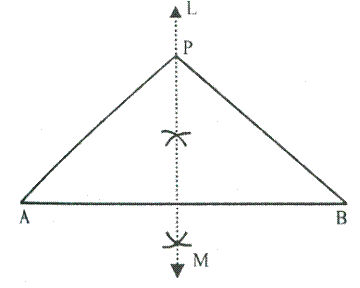
Steps of construction:
(i) Draw a line segment AB of 6 cm.
(ii) Draw perpendicular bisector LM of AB. LM is the required locus.
(iii) Take any point on LM say P.
(iv) Join PA and PB.
Since, P lies on the right bisector of line AB.
Therefore, P is equidistant from A and B.
i.e. PA = PB
Hence, Perpendicular bisector of AB is the locus of all points which are equidistant from A and B.
Draw an angle ![]() . Draw the locus of all points equidistant from AB and BC.
. Draw the locus of all points equidistant from AB and BC.

Steps of Construction:
i) Draw a ray BC.
ii) Construct a ray RA making an angle of ![]() with BC. Therefore,
with BC. Therefore, ![]() .
.
iii) Draw the angle bisector BP of ![]() .
.
BP is the required locus.
iv) Take any point D on BP.
v) From D, draw ![]() and
and ![]()
Since D lies on the angle bisector BP of ![]()
D is equidistant from AB and BC.
Hence, DE = DF
Similarly, any point on BP is equidistant from AB and BC.
Therefore, BP is the locus of all points which are equidistant from AB and BC.
Draw an angle ![]() , having AB = 4.6 cm and BC = 5 cm. Find a point P equidistant from AB and BC; and also equidistant from A and B.
, having AB = 4.6 cm and BC = 5 cm. Find a point P equidistant from AB and BC; and also equidistant from A and B.
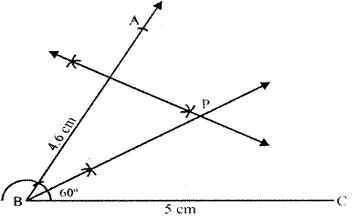
Steps of Construction:
i) Draw a line segment BC = 5 cm
ii) At B, draw a ray BX making an angle of ![]() and cut off BA = 4.6 cm.
and cut off BA = 4.6 cm.
iii) Draw the angle bisector of ![]() .
.
iv) Draw the perpendicular bisector of AB which intersects the angle bisector at P.
P is the required point which is equidistant from AB and BC, as well as from A and B.
In the figure given below, find a point P on CD equidistant from points A and B.
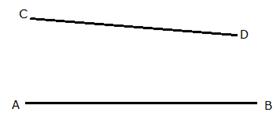

Steps of Construction:
i) AB and CD are the two lines given.
ii) Draw a perpendicular bisector of line AB which intersects CD in P.
P is the required point which is equidistant from A and B.
Since P lies on perpendicular bisector of AB; PA = PB.
In the given triangle ABC, find a point P equidistant from AB and AC; and also equidistant from B and C.
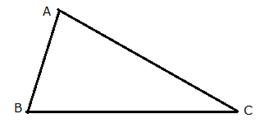

Steps of Construction:
i) In the given triangle, draw the angle bisector of ![]() .
.
ii) Draw the perpendicular bisector of BC which intersects the angle bisector at P.
P is the required point which is equidistant from AB and AC as well as from B and C.
Since P lies on angle bisector of ![]() ,
,
It is equidistant from AB and AC.
Again, P lies on perpendicular bisector of BC,
Therefore, it is equidistant from B and C.
Construct a triangle ABC, with AB = 7 cm, BC = 8 cm and ![]() . Locate by construction the point P such that:
. Locate by construction the point P such that:
i) P is equidistant from B and C.
ii) P is equidistant from AB and BC.

Measure and record the length of PB.
Steps of Construction:
1) Draw a line segment AB = 7 cm.
2) Draw angle ![]() with the help of compass.
with the help of compass.
3)Cut off BC = 8 cm.
4)Join A and C.
5)The triangle ABC so formed is the required triangle.
i) Draw the perpendicular bisector of BC. The point situated on this line will be equidistant from B and C.
ii) Draw the angle bisector of ![]() . Any point situated on this angular bisector is equidistant from lines AB and BC.
. Any point situated on this angular bisector is equidistant from lines AB and BC.
The point which fulfills the condition required in (i) and (ii) is the intersection point of bisector of line BC and angular bisector of ![]() .
.
P is the required point which is equidistant from AB and AC as well as from B and C.
On measuring the length of line segment PB, it is equal to 4.5 cm.
On a graph paper, draw lines x = 3 and y = -5. Now, on the same graph paper, draw the locus of the point which is equidistant from the given lines.
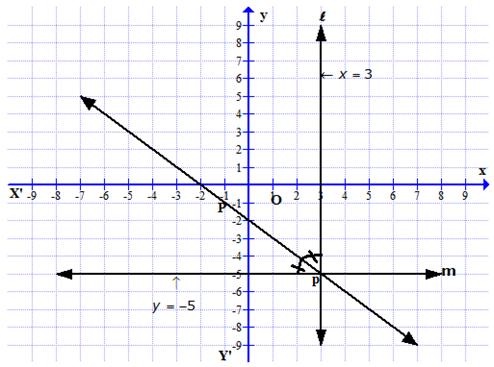
On the graph, draw axis XOX’ and YOY’
Draw a line l, x = 3 which is parallel to y-axis
And draw another line m, y = -5, which is parallel to x-axis
These two lines intersect each other at P.
Now draw the angle bisector p of angle P.
Since p is the angle bisector of P, any point on P is equidistant from l and m.
Therefore, this line p is equidistant from l and m.
On a graph paper, draw the line x = 6. Now, on the same graph paper, draw the locus of the point which moves in such a way that its distance from the given line is always equal to 3 units.
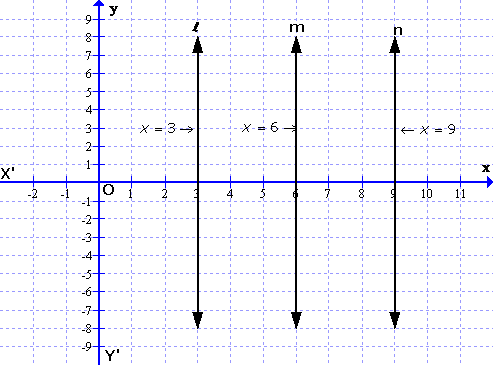
On the graph, draw axis XOX’ and YOY’
Draw a line l, x = 6 which is parallel to y-axis
Take points P and Q which are at a distance of 3 units from the line l.
Draw lines m and n from P and Q parallel to l
With locus = 3, two lines can be drawn x = 3 and x = 9.
No comments:
Post a Comment